Matador Network's Blog, page 1170
February 1, 2019
Martin Luther King’s house to open

The home of Dr. Martin Luther King, Jr., located in the Vine City neighborhood of Atlanta, Georgia, is about to be open to the public for the first time ever. The brick house, where he moved to in 1965 with his wife Coretta Scott King and his children, is now officially the property of the National Park Service, and will eventually be part of the broader Martin Luther King, Jr. National Historical Park.

Photo: Katie Bricker Photography for the National Park Foundation
The National Park Foundation purchased the home for $400,000 via private philanthropy on January 8, 2019, and also acquired King’s birth home for $1.9 million in December 2018. Both homes were then transferred to the National Park Service. The foundation hopes to use the two sites to provide greater access to King’s life and legacy, and tell a more comprehensive American story through national parks.

Photo: Katie Bricker Photography for the National Park Foundation
Dr. King’s daughter, Dr. Bernice A. King, said, “We are very pleased to have worked with the National Park Foundation to ensure that the family home that my siblings and I grew up in will be open and available to the public. My brothers and I are honored to have fulfilled my mother’s wish to allow future generations to know the story of our dad as a father, a husband, a minister, and a civil rights leader.”
Before it opens to the public, however, the home must undergo assessments, repairs, and restorations, and is not expected to open for tours until next year. 
H/T: Lonely Planet

More like this: These are the 25 cultural heritage sites that are most at risk
The post Martin Luther King’s family home is now part of the National Park System appeared first on Matador Network.

Get paid to drive a chocolate truck

Your New Year’s resolution to eat healthier just went down the tubes. Tony’s Chocolonely, a chocolate company with US headquarters in Portland, Oregon, is offering three full-time, salaried positions for people who want to take a road trip across the United States in a truck filled with chocolate. Obviously, there’s more to the job than eating tons of chocolate — the point is to spread the the company’s mission: fighting to end modern slavery and illegal child labor on West African cocoa farms.
The chocolate company is looking for one Chocotruck Captain and two Choco Co-Pilots to drive a Chocotruck (a big, bright red food truck) loaded with tons of chocolate bars to various places around the country. At each stop, people will be able to tour the truck, learn about the company’s mission, and sample chocolates.
Tour stops include:
Austin, Texas
Phoenix, Arizona
San Diego, California
Los Angeles, California
San Francisco, California
Berkeley, California
Eugene, Oregon
Portland, Oregon
Seattle, Washington
Chicago, Illinois
According to the job description, the captain will be responsible for driving and maintaining the truck, running the events, managing the co-pilots, tour logistics, photos, daily recaps and reports, and keeping track of inventory. Meanwhile, co-pilots will be assisting with event setup, taking photos, and assisting fans with trying and buying the chocolate.

Photo: Tony’s Chocolonely/Facebook
It goes without saying that you’ll need valid driver’s license and a clean driving record. You’ll also need to be 21 or older and authorized to work in the US. Most importantly, the job description insists that applicants have a positive attitude, a sense of humor and adventure, and be flexible.
The job is is a four-month opportunity — with a possible extension and even a permanent position — and comes with a “very competitive” salary and perks. To apply, visit the official application site. 
H/T: Thrillist

More like this: The ultimate European bucket list trip for chocolate lovers
The post Get paid big bucks to drive across the US and stuff your face with free chocolate appeared first on Matador Network.

Mining sites you can visit

Whether you’re in it for the spine-chilling descent hundreds of feet underground or the fascinating tales of dark history, abandoned mines can be great adventure or cultural additions to your travel itinerary. Some date all the way back to the 1000s, while others offer activities like Ferris wheel rides and even scuba dives, all deep below the earth’s crust. Check out these seven abandoned mines across the world that have been transformed into tourist attractions that you can visit (and learn from) on your next trip.
1. Bonne Terre Mine — Bonne Terre, Missouri
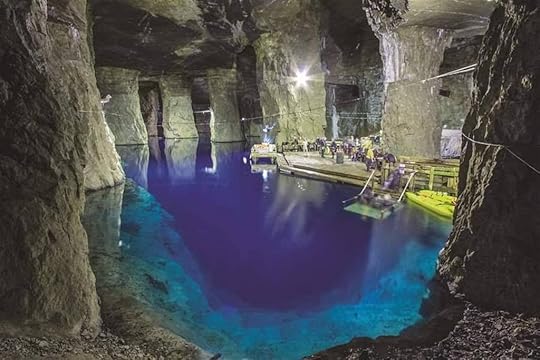
Photo: The Mine at Bonne Terre/Facebook
Just a quick hour south of St. Louis, visitors can explore what’s left of Bonne Terre Mine, one of the earliest deep-earth lead mines in history and still one of the largest man-made caverns in the world. Bonne Terre Mine was the world’s largest producer of lead ore until it was closed in 1962, more than 100 years after its opening in 1860.
Today, Bonne Terre Mine is one of the main tourist attractions in the state of Missouri. The upper levels of the mine are lighted, and visitors can book one-hour guided walking tours along the old mule trails, where miners dug with picks and shovels over a century ago.
Visitors can also opt to descend deeper into the cavern, taking a boat tour of the billion-gallon, seventeen-mile-long lake that sits far below the surface of the earth. Boat tours afford eerie views of the mine’s abandoned shafts and equipment. But the bravest of souls will want to check out “deep earth diving” — Bonne Terre Mine is home to the largest freshwater scuba diving venue in the world. The lake’s clear, 58-degree water is illuminated from above, providing divers with visibility more than 100 feet down.
2. Slate Caverns — Snowdonia, Wales

Photo: The Slate Caverns/Facebook
Visitors can descend into the Slate Caverns in Snowdonia, Wales, to experience everyday life as the mine workers knew it. When the Industrial Revolution exploded onto the scene and demand for slate hit its peak, the Slate Caverns employed over 17,000 men. The expansive underground caves are illuminated in eerie colors, giving the tour a truly spooky feel, and visitors can even opt to zip line, jump, and climb in the cavern’s underground playground.
When in Wales, you may also want to check out the Great Orme Mines in Llandudno — the tunnels were mined out during the Bronze Age (over 3,500 years ago) in search of copper, and miners at the time would’ve worked with nothing more than stone and bone tools. The Great Orme Mines weren’t re-discovered until 1987.
3. Kolmanskop, Namibia
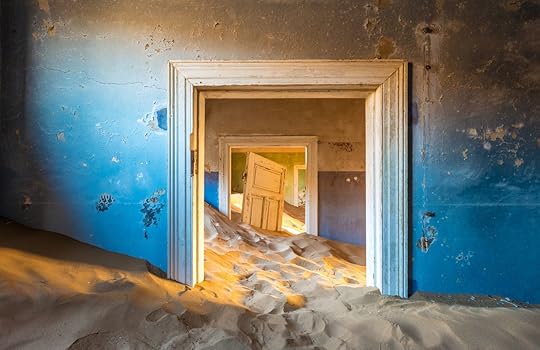
Photo: Kanuman/Shutterstock
The sandy ghost town of Kolmanskop, located in the barren Namib Desert of southern Namibia, sprung up as a booming German diamond mining town in the early 1900s. However, when World War I broke out, mining operations came to a halt, and the desert has spent the years since reclaiming its territory.
Today, what’s left of the town, including the mine, is covered in sand, which encroaches even into the interior of the buildings. By booking a tour in Luderitz, visitors can explore the houses and community buildings left behind by the Germans after mining operations ceased — at least until the elements swallow the uninhabited area completely.
4. Salina Turda — Turda, Romania
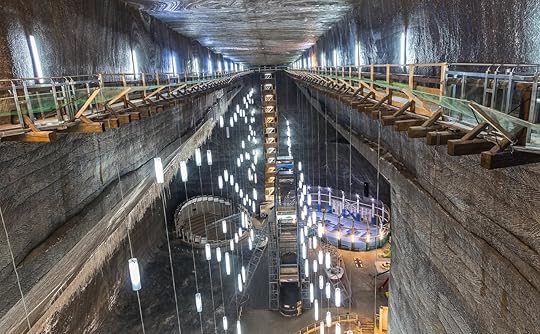
Photo: Salina Turda/Facebook
One of the most interesting spots in Transylvania, Salina Turda is a massive underground salt mine that dates all the way back to 1075. It continuously produced table salt from the Middle Ages up until the early 20th century.
Today, it’s used as a popular halotherapy center and tourist attraction, with the amenities inside nearing amusement park levels. Visitors can view the extraction equipment, explore the underground lake via rowboat, experience the acoustics of the amphitheater, and even ride a Ferris wheel, all deep inside Salina Turda’s chilling depths.
5. Wieliczka Salt Mine — Wieliczka, Poland

Photo: Alfredo Garcia Saz/Shutterstock
The site of the Wieliczka Salt Mine — also known as Poland’s Underground Salt Cathedral — dates back 6,000 years. However, the first mining shafts were not built until the turn of the 13th century.
The mine went on to become one of the oldest operating salt mines in the world, producing table salt all the way up until 2007, and is now one of Poland’s official Historic Monuments. It’s also one of the largest tourist attractions in all of Poland, with more than a million visitors annually. Underground, visitors can explore winding passageways, four chapels, an underground lake, and even statues that were carved out of rock salt by the miners.
6. Gold Reef City — Johannesburg, South Africa

Photo: Gold Reef City/Facebook
In Johannesburg, one of the top attractions for families is a theme park built on top of an old gold mine. Though Gold Reef City began its life as a working mine, it has since transformed into an action-packed theme park modeled to resemble the Gold Rush era of the 1880s. Staff don period costumes and the buildings are built to mimic the architecture of the time. Theme park-goers who want to add a bit of education to their day can even visit a museum and watch a demonstration centered around gold mining.
7. Quarry Park and Nature Preserve — St. Cloud, Minnesota
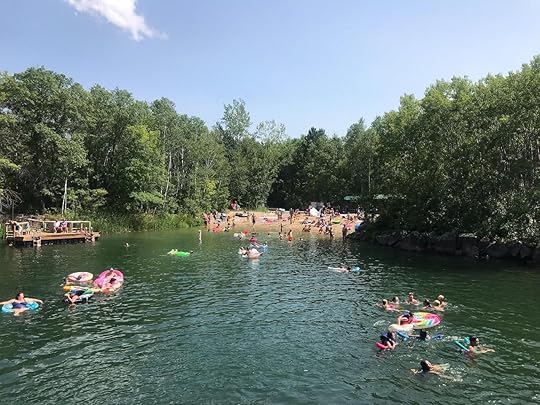
Photo: Visit Greater St. Cloud/Facebook
Located on the outskirts of St. Cloud, Minnesota, Quarry Park and Nature Preserve spans over 680 acres with 20 abandoned granite quarries. Today, those abandoned quarries are used for a variety of activities, including swimming, climbing, fishing, peering into the granite-reflecting pools, scuba diving, and — of course — capturing some envy-inducing Instagram photos. The county park also has miles of walking paths, allowing visitors to travel from quarry to quarry, as each has its own unique backstory. 

More like this: 7 epic caves you can hike through in the US
The post 7 abandoned mines that are now awesome tourist attractions appeared first on Matador Network.

January 31, 2019
Ski resorts and apres ski in BC

Skiers know British Columbia’s Powder Highway as a place full of quirky towns, local ski resorts, and some of the best skiing a powder hound could ask for. But after decades of après options centered on nacho platters and beer, a couple of stops on the Powder Highway have been seriously improving their dining scene. You can now sample eats from a new food truck snowcat, dine at mountain-top restaurants, or sip craft beer and cocktails — all after hitting some of the region’s best ski slopes.
What is the Powder Highway?
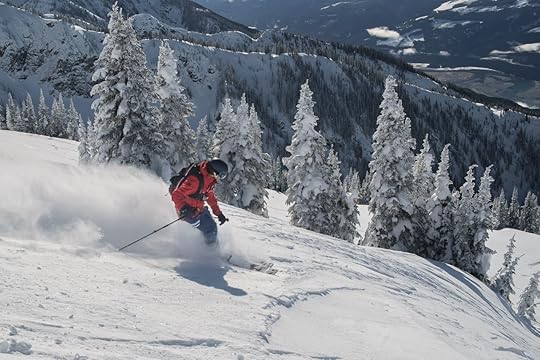
Photo: Jiri Kulisek/Shutterstock
British Columbia’s Powder Highway loops eight ski resorts, one-time mining towns, current hippie outposts, and a handful of hot springs to boot — all concentrated in the Kootenay region in the province’s eastern side. It’s a year-round destination whether you’re into scenic drives, local beer, whitewater rafting and hiking, or all manner of snow sports. You can also enjoy excellent meals centered on seasonal, local ingredients at resorts like Panorama and Kicking Horse.
This region of British Columbia sees far fewer visitors than Whistler to the west or Banff National Park and Lake Louise in the neighboring Alberta province. Here in the quiet Kootenays, you can ski in the morning, eat a five-course meal in the evening, and end the day with a dip in a hot pool — far from the crowds.
Panorama Mountain Resort

Photo: Panorama Mountain Resort/Facebook
When you ski Panorama Mountain Resort’s 3,000 acres, chances are you’ll have plenty of elbow room. Despite the great powder, the resort doesn’t see the throngs of visitors that other mountains, closer to major metro areas, do. Plus, the recent addition of Taynton Bowl, a former heli-skiing area, is giving powder-seekers even more room to roam. The runs here all funnel down the mountain into a compact village, so Panorama is an especially easy place to come with friends or family members of varying abilities — you’ll all end up in the same place at the end of the day.
Panorama’s après scene is strong at ElevenFifty, which skews casual with dishes like homemade pasta, braised meatballs, and gnocchi elk ragout, all complemented by an excellent British Columbia-focused wine list. Panorama puts its own twist on the food-truck trend with Snowlicious, a snowcat converted into an eatery. You’ll find it parked slopeside, serving grab-and-go food that’s easy to eat without taking off your ski gloves.
Diners can eat local at Cliffhanger Restaurant, which overlooks the Purcell Mountains. The space is elegant, with high ceilings, large windows, and exposed beams. No surprise it’s popular as a wedding venue. Food here pays homage to Canadian ingredients like mussels from Prince Edward Island, fish from British Columbia, and beef from Alberta.

Photo: Panorama Mountain Resort/Facebook
The ski-in Elkhorn Cabin, perched midway down the slopes, hosts groups for Swiss-style raclette dinners, which involve grilling your own food — like beef, cheese, and vegetables — tableside. The restaurant also serves local BC wine and beer to go with your meal. Afterwards, you have the option of a lamplight ski out or a trip down the hill in a snowcat. Either way, the alpine views are spectacular.
The Cabin, a cozy bar in the village, satiates cocktail cravings with plenty of classics and originals. If you’re still hungry, the bar smokes the meats and produce that make up the bulk of its menu. Need help digesting and soothing those tired muscles? Take a dip in Canada’s largest slopeside hot pools in the heart of the resort. Follow it up with a sauna visit before you call it a night.
Kicking Horse Mountain Resort and the town of Golden
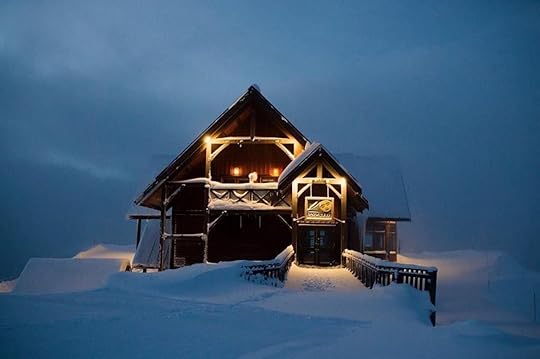
Photo: Kicking Horse Mountain Resort/Facebook
At Kicking Horse, the skiing is all about steep and deep. The runs here aren’t just mowed-over hillsides; you’re skiing pristine high-alpine bowls and glades. Even better: These choice runs aren’t limited only to the most experienced skiers as there are options for beginners, too.
The resort restaurant scene’s crown jewel is Eagles Eye, perched at the top of Kicking Horse Mountain. Accessible by gondola, skiers and non-skiers alike convene here for lunch and dinner. Special events like multi-course winemaker dinners are even more dramatic with views extending out among the nearby peaks.
Start your day on the slopes with breakfast and espresso at Double Black Café, which sits at the foot of the gondola. Fuel up on baked goods and breakfast staples like tricked-out avocado toast, chilaquiles, or breakfast parfait.

Photo: Whitetooth Brewing Company/Facebook
Just down the mountain from Kicking Horse sits the town of Golden, with its compact downtown along the Kicking Horse River. Locals pack into Whitetooth Brewing Company for well-made brews complemented by the occasional food truck. A tasting flight here is the perfect primer before an elegant dinner at Whitetooth Bistro, a short walk away. The plates here balance hearty food and perfect presentation — washed down with the bar’s impressive original cocktails or a glass of British Columbia wine.
Other foodie stops along the way
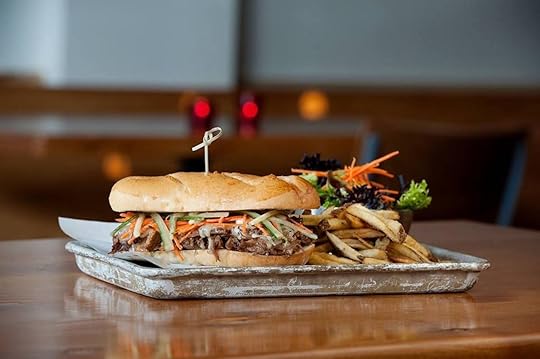
Photo: Pedal & Tap/Facebook
While Panorama and Kicking Horse get top marks for dining on the Powder Highway, other resorts hold their own. Local beer washes down legendary prime rib burgers at Fernie Alpine Resort’s Griz Bar while you can get a great brie burger in Fernie at The Brickhouse. Visit the town of Kimberly, below Kimberly Alpine Resort, for refined eats and BC wine at Pedal & Tap. Big portions at Revelstoke Mountain Resort’s Rockford Grill will help you fuel up for the next day’s adventures. 

More like this: Okanagan Valley: Exploring inland British Columbia
The post Eat well and ski hard on British Columbia’s Powder Highway appeared first on Matador Network.

Must-try South Korean desserts

Gone are the days when South Korean food in America only referred to Korean barbecue. Bibimbap and kimchi grace menus, and traditional flavors have blended with other cuisines to make a new category of Korean burgers and tacos. Part of that popularity is because Korean food is one of the healthiest cuisines in the world, but one side of the food — the decidedly less healthy side — is still often left out: dessert.
That’s a shame because there’s a Korean dessert for just about every occasion, whether you want something to warm you up through a harsh winter or cool you down in a blisteringly hot summer. These are the Korean desserts you’ve been missing out on.
Songpyeon

Photo: sungsu han/Shutterstock
Shaped into a similar half-moon shape as dumplings, these bite-sized packages are made with a rice flour dough shell that’s filled with ingredients like red bean paste, honey, chestnut, and sesame. The dough is often various colors. Songpyeon is traditionally served during the Korean celebration of chuseok (a fall harvest festival that translates to “autumn eve”). The taste is sweet, nutty, and chewy, with a subtle pine tree flavor from steaming the rice cakes in fresh pine needles (the song in songpyeon means pine tree). Songpyeon are perfect for anyone who enjoys mochi and chewy desserts.
Dasik

Photo: Image Republic/Shutterstock
These delicate patterned cookies look too attractive to eat. Do it anyways. Usually made from rice flour or soybean flour, dasik come in a range of natural colors and flavors and are pressed into a mold to imprint shapes, letters, and flower patterns. The colors generally match the flavor. For example, matcha dasik are green, sesame seed are black, and so on. Typically served with tea, they’re light and not too sweet. The soft texture melts in your mouth. Dasik date back to the Joseon Dynasty (1392-1910) when the cookies were piled high on a plate as an important part of ancestral rites, holidays, and other ceremonies. Different flavors also served as medicine, with the sesame treating food poisoning and the acorn used to suppress a cough.
Chapssaltteok

Photo: Yulia K/Shutterstock
Chapssaltteok is a rice cake made with glutinous rice and is similar to Japanese mochi. The popular snack is often given to people taking the university entrance exam to sweeten up what is otherwise a long string of days filled with studying. Chapssaltteok is typically filled with red bean paste or fruit. Extremely thick and chewy, this is a dessert that’ll keep you full for a while.
Hodo-gwaja

Photo: sungsu han/Shutterstock
Hodo-gwaja look and taste like walnuts. The outside is a breading made with crushed walnuts and wheat flour that’s similar to a pancake in texture, and the inside has red bean paste and more walnut. A couple, Jo Gwigeum and Sim Boksun, first created hodo-gwaja in 1934, and they’ve slowly become a favorite in Korea. Hodo-gwaja are best served eaten hot — particularly with a hot drink alongside it.
Bungeoppang

Photo: NavyBank/Shutterstock
Bungeoppang translates to “carp bread.” The name doesn’t disappoint. The treat is fish-shaped and somewhat like a cross between a waffle and a pancake that’s filled with red bean paste. Other fillings include custard, sweet potato, and if you’re on Jeju island, cheese. The street food is popular in the winter in Korea, where you’ll find stalls selling bungeoppang cooked in little fish-shaped molds. They are crispy on the outside and soft on the inside — perfect for an on-the-go dessert.
Hotteok

Photo: NavyBank/Shutterstock
Where North America has hot cakes, Korea has hotteoks. The pancake-looking dessert is filled with honey, cinnamon, and nuts. Popular in the winter, hotteoks have a crispy outside and chewy inside that’s slightly crunchy and syrupy. Eat them straight out of the pan for the best experience.
Gotgamssam

Photo: nickichen/Shutterstock
Fruit is the key element in gotgamssam. The treat is made with a walnut that’s wrapped in a dried persimmon. Some of the sweeter versions are smothered in honey. The whole thing is thinly sliced and served alongside tea.
Bingsu

Photo: Ballz3389/Shutterstock
Easily the most popular Korean dessert outside of Korea, bingsu (shaved ice) is the crowning glory of desserts to rescue you from a scorching summer day. It’s made up of a large portion of shaved ice that’s topped with sweetened condensed milk, syrup, and classic toppings like red bean, mango, or green tea. Simple bingsu is served up in a cup while more elaborate affairs come in half of a watermelon or coconut. It’s a lot to take on at once, and sharing is perfectly acceptable. 

More like this: The most calorific desserts around the world
The post 8 sweet, chewy, and colorful Korean desserts you’re missing out on appeared first on Matador Network.

Best things about Blackmore Vale

With its thatched roof cottages and cobblestone streets, it’s no wonder why so many tourists flock to the Cotswolds in droves. Plenty of tours come in from London filled with people trying to see the “real” English countryside, which unfortunately means expensive accommodations, touristy pubs, and, in the high season, crowded streets blocking you from getting that picture-perfect view. No matter — there’s another region further south in England that offers traditional villages, historical significance, and spectacular rural landscapes all without the crowds: Blackmore Vale.
Tucked southwest of London between North Dorset and South Somerset, Blackmore Vale is one of the most charming spots in all of the United Kingdom. You must set out both by car and on foot to the historic sites and quaint villages; only then can you taste the old England and see for yourself what makes this region a must-do for those looking to escape London’s urban grind. Here’s how to discover Blackmore Vale’s rich history, warm community, and beautiful views that are straight out of a fairytale.
Start with a walk around Iron Age hillforts.
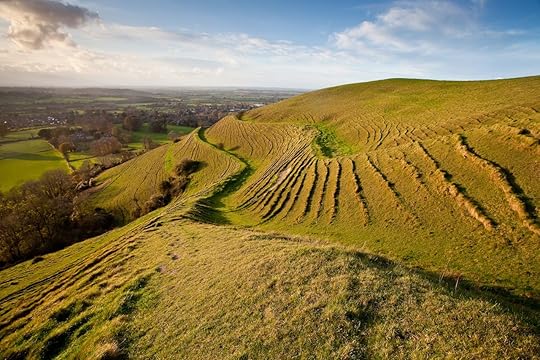
Photo: Terry Yarrow/Shutterstock
The views from the top of Hambledon Hill are enough to take your breath away. This ancient hill, occupied in Neolithic times, is best known for its Iron Age settlement. The location was occupied by the Durotriges tribe, and during the English Civil War, it was the site of the Battle of Hambledon Hill. Today, distinctive rings around the perimeter mark out the signs of its settlement more than 2,000 years ago. Although it was abandoned in 300 BC, you can still walk around the traces of the defenses and imagine what it must have been like to have been on the lookout for invading rival tribes back in those times. If you’re hooked on hikes to former battle sites, nearby Hod Hill is similar, and they are both offer fantastic views.
Get “the shot” atop Gold Hill.
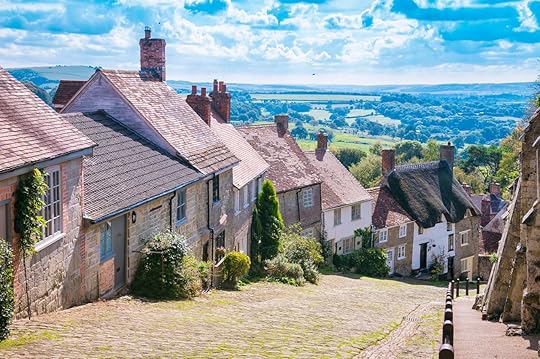
Photo: lazyllama/Shutterstock
The hilltop town of Shaftesbury was founded by King Alfred the Great in 880 AD, and even today, it’s one of the most beautiful parts of the Blackmore Vale. It’s also quite easy to access, just off the A350 highway in Dorset. On the edge of town is Shaftesbury Abbey, also founded by King Alfred, where today you can walk around the ruins and museum on this large garden plot. The walled garden and museum tell the story of the Benedictine nunnery King Alfred, founded on the site more than 1000 years ago, before an order of destruction was filed by King Henry VIII in 1539. In a more modern reference, most people come to Shaftesbury to see the quaint Gold Hill — which has starred in numerous TV adverts and movies and is one of the steepest hills in the area. Cottages clustered into the sides of the hill all lean against each other, creating an unmatched photo opportunity. You’ll get the most stunning shot if you arrive early for sunrise.
About a half-hour drive west, the honey-colored buildings of Sherborne give the village a warm feel. This country town is full of independent businesses and is famous for Sherborne Abbey, a magnificent piece of architecture where Alfred the Great’s brothers are buried. Nearby, Sherborne Castle was once owned by Sir Walter Raleigh.
Party like it’s 1780.

Photo: Vivvi Smak/Shutterstock
The village of Milton Abbas is tucked away in the Dorset countryside, full of gorgeous thatched cottages, but its story is what sets it apart from other picturesque villages. In the 1780s, the local landowner decided that the village — with its seemingly unpleasant conical structures called hovels — spoiled the view across his land. In retaliation, he forced everyone to relocate a mile down the road, a move that hasn’t been forgotten despite the passage of nearly 250 years. Every other year, the entire village turns the clock back for the Milton Abbas Street Fair to celebrate the famous house move. If you can make it, the party takes place in July and is complete with Morris dancing, traditional music, and street food.
See the towns that inspired Thomas Hardy’s novels.
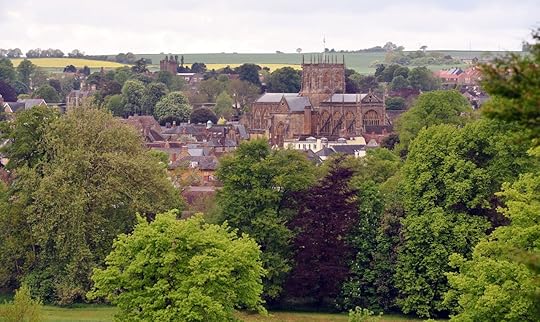
Photo: Paul Appleyard/Shutterstock
Most towns and villages in North Dorset have a second name given to them by Thomas Hardy in his novels. Stourcastle from Tess of the D’Urbervilles is actually Sturminster Newton, a town Hardy lived in throughout his early writing days. Sherton Abbas, the setting of The Woodlanders, is, in reality, the town of Sherborne. When Hardy famously described the Vale of a Hundred Dairies, he was talking about the Blackmore Vale. One look at the honey-colored cottages and pastoral landscape, and you will see why Thomas Hardy was inspired to write stories based on these settings.
Feel welcomed into the region’s strong sense of community.
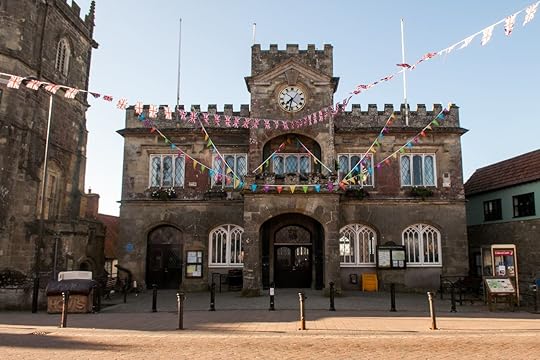
Photo: Joe Dunckley/Shutterstock
One of the best and most unique things about the Blackmore Vale is its preserved sense of community. It’s the kind of place where locals volunteer to keep the area an interesting place to visit and a wonderful place to live. You’ll see this spirit in the village centers and stores run by residents to keep the service open in a rural community, such as the award-winning Motcombe Community Shop near Shaftesbury, which serves as a cafe, post office, and dry cleaners. A new walking trail spanning 50 miles of Blackmore Vale countryside to connect towns and villages, known as the White Hart Link, is maintained by local communities and volunteers. In 1963 the Shillingstone Station closed, but today, volunteers have a local museum and tearoom that features restored vintage engines and parts of the old railroad track. This amazing project is on the North Dorset Trailway, another wonderful walking and cycling route in the area. One of the world’s most famous festivals, the Great Dorset Steam Fair, started out right here in the Blackmore Vale just over 50 years ago and is a major attraction even today. 

More like this: Smithfield’s dark, grizzly past makes it the most fascinating district in London
The post Skip the Cotswolds — Blackmore Vale is the storybook England of your dreams appeared first on Matador Network.

W Trek in Torres del Paine views
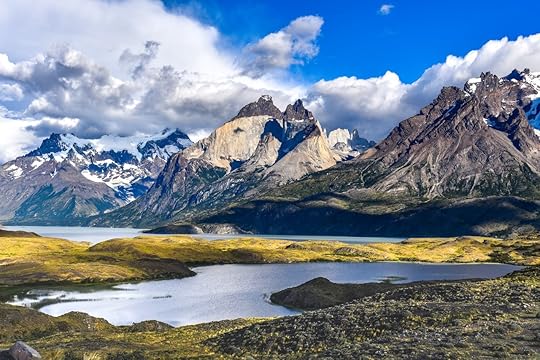
The W Trek of Torres del Paine National Park in Chilean Patagonia is one of the must-do multi-day hiking trails in the world. Winding in a “W” shape from one end of the Paine Massif mountains to the other, the trek takes hikers past some of the regions best sights: the Grey Glacier, the Torres, and the French Valley. At almost every step along the way, backpackers come face to face with some of the most stunning natural vistas anywhere in the world, from mountains blown and ground into incredible shapes to crystalline lakes dotted with icebergs to ethereal forests. Although it’s hard to pick favorites on an amazing a trek like this, here are the most gorgeous sites along the W Trek in Torres del Paine.
The base of the Torres
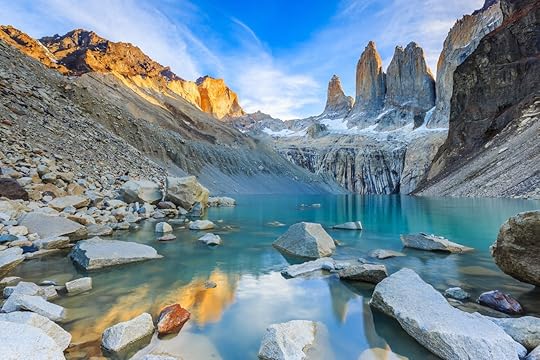
Photo: emperorcosar/Shutterstock
Apart from the sculpted granite horns of the Cuernos on the front of the Paine Massif, the base of the Torres is probably the most iconic site in Torres del Paine: three granite spires rising over an aquamarine lake cradled in a glacier-carved bowl. But getting to that astonishing view is not without effort. On average, it’s an eight-hour round trip hike up into the bowels of the Paine Massif, traversing rocky and uneven terrain and a craggy moraine before the summit. But at the end of it, you get to sit by the lake and admire the three eponymous towers of stone. While the views are unbeatable no matter the time of day, many hike in the morning from Refugio Chileno to see the sun rise over the Torres.
Hiking into the Ascencio Valley
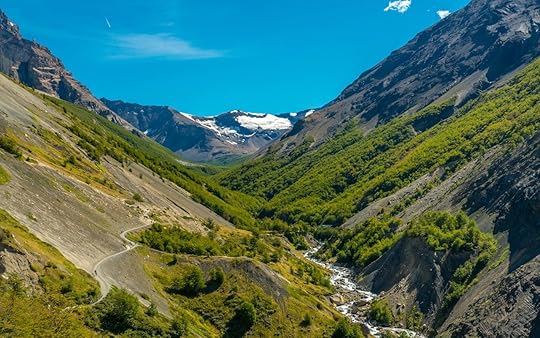
Photo: Milonk/Shutterstock
To reach the Torres requires trekking up and into the heart of the massif, which is no small feat. Starting from the Las Torres Hotel, you can follow a path that leads up the rocky base of Monte Almirante Nieto toward a V-shaped valley between it and Cerro Paine. Upon reaching the head of the valley, the path hugs the side of the canyon as it descends. On either side, mountains spliced by waterfalls tower overhead, with green forests filling the floor of the valley and the Ascencio river tumbling down from the far end of the basin. Once you get to the Refugio Chileno, you can also see the Torres peeking around the mountains further down the valley.
The view of Paine Massif and Lake Nordenskjold

Photo: Otavio Oliva/Shutterstock
One of the most stunning sights in the park are the lakes, which, thanks to minerals and sediment from the melting glaciers that feed them, have taken on unreal technicolor hues. One of the best examples is the bright turquoise of Lake Nordenskjold. Straddling the base of the massif, if you’re hiking from the east end of the W Trek toward Refugio Los Cuernos, you’ll catch your first glimpse of this shockingly blue lake. Fringed by Patagonian flatlands, with Monte Almirante Nieto and the Cuernos rising above on the right-hand side, it’s definitely a spot to stop and appreciate the view.
Grey Glacier from suspension bridges near Refugio Grey
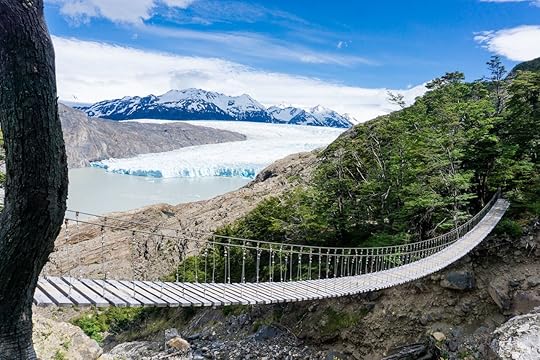
Photo: Scott Biales/Shutterstock
The Grey Glacier is one of the three main highlights of the W. Hiking along the far western side of the massif, you’ll see the glacier getting closer as you head north toward Refugio Grey, but to get the best view you’ll need to go a bit further on past the Refugio.
There are two suspension bridges once you get closer to the glacier where, if you’re doing the full Paine circuit that encircles the massif, you’ll be heading for John Gardner Pass. Both have amazing views of the glacier, Grey Lake, and surrounding landscapes, but the second suspension bridge is arguably the better of the two. It hangs over a rocky gorge, with green forests on either side. Off to the left, you can see Lake Grey, and it puts you practically parallel to the front wall of the Grey Glacier.
Grey Glacier Lookout
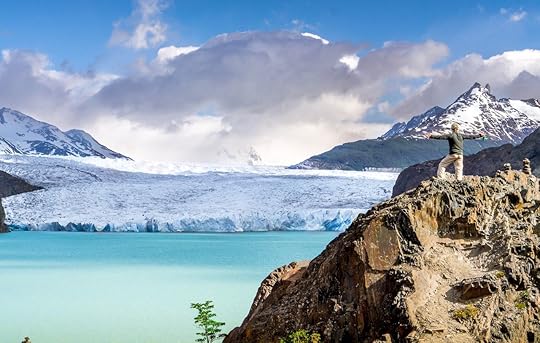
Photo: Scott Biales/Shutterstock
If you don’t want to go all the way to the suspension bridges for a view, there’s a closer lookout only about a 10-15 minute walk from the Refugio Grey site. Here you’ll be able to take in the blue and white front wall of the glacier and see it stretching back into the Southern Patagonian Icefield. You’ll also see icebergs scattered in the teal waters of Grey Lake, and the tiny islands jutting up from the front of the wall. The wind coming off the glacier can be brutal, but the view is worth it.
Mirador Britanico in the French Valley
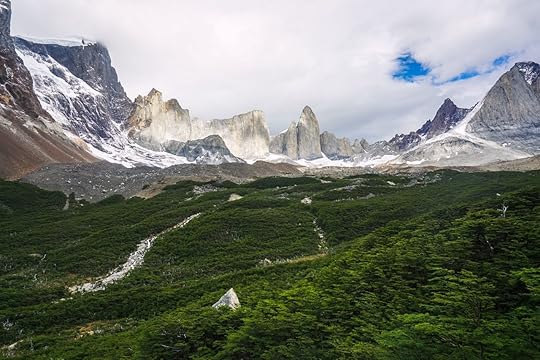
Photo: Larissa Chilanti/Shutterstock
Right smack dab in the middle of the Paine Massif, the French Valley is somewhat unworldly. The bowl-shaped valley of streams and rivers, rocky terrain, and forests is surrounded by spectacularly shaped rock formations. From this viewpoint at the far end of the valley, you can take in the entire basin and the rim of mountains that encircles everything. As one of the harder to reach viewpoints on the trek, it’s usually a peaceful spot to sit and soak it all in.
View of Los Cuernos and Lago Pehoe from Refugio Paine Grande

Photo: marktucan/Shutterstock
Refugio Paine Grande is one of the largest camping sites on the trek as it is an ideal starting or ending point thanks to its catamaran, which connects to Pudeto on the other side of Lake Pehoe. From the site, nestled against a large hill alongside Lake Pehoe, you can see the towering shape of the main Cuerno horn with its distinctive light grey body and dark grey caps. A perfect sight to take in after a long day of hiking.
View of the Frances Glacier at the entrance to French Valley
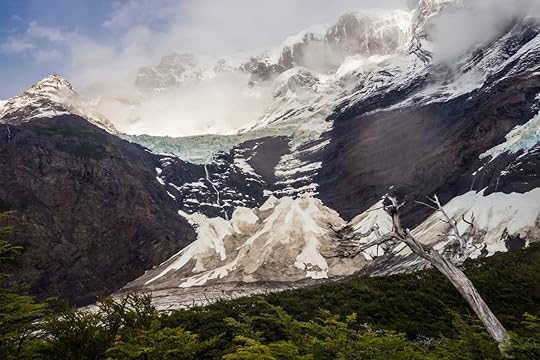
Photo: Erlantz PR/Shutterstock
If you’re not able to hike all the way into the French Valley to the Britanico Lookout, the Frances Viewpoint at the entrance to the basin is still a spot worth reaching. Not only will you get your first glimpse into the valley and a distant view of Lake Nordenskjold, but you’re also directly opposite the Frances Glacier, a hanging glacier that frequently calves and causes small avalanches to cascade down the walls. The rumbling sound of the avalanches echoes throughout the region, and it’s a beautiful spot to appreciate the raw power of nature.
Mirador Cuernos
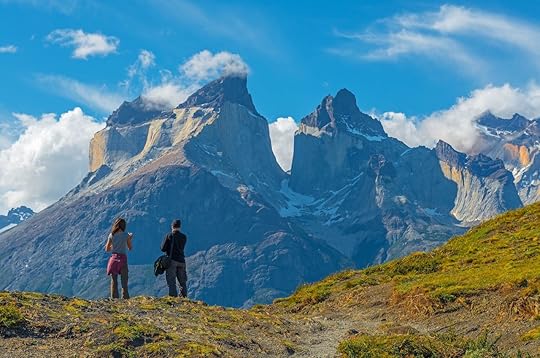
Photo: SL-Photography/Shutterstock
While not technically on the trek, this lookout offers a panoramic view of Paine Massif, particularly the Cuernos, and is definitely worth trying to squeeze into your W trek either at the beginning or end. During the trek itself, it’s hard to appreciate the sheer scale and majesty of the Cuernos since you’re trekking at their base, but this lookout on the opposite shore of Lake Nordenskjold has one of the best views of the Cuernos in the park. Also, if you’re ending at the Pudeto Catamaran launch, you can take a short walk to the lookout and see the Salto Grande waterfall. If you don’t have time to do this before hopping on the bus back, be sure to grab a window seat on the catamaran as the views during the crossing are also wondrous. 

More like this: Why Chile is the perfect gateway trip to South America
The post The most gorgeous sights along the W Trek in Torres del Paine appeared first on Matador Network.

Best things about Bern, Switzerland

Walking along Bern’s cobblestone streets, between sandstone buildings and under swaths of arcades through the peninsular Altstadt or Old Town, you’re bound to experience the signature Bernese slow lifestyle that Switzerland’s capital is known for. While checklist-minded travelers gather around this quiet town’s famous Zytglogge, the 13th-century clock tower, to watch the hour strike and the figures come to life, there is more to take from Bern than its popular sites — and perhaps enough to take back home with you to the US. Here are five things you’ll realize about life in Bern during your trip, which will probably make you never want to leave.
1. Proper infrastructure makes life much smoother.
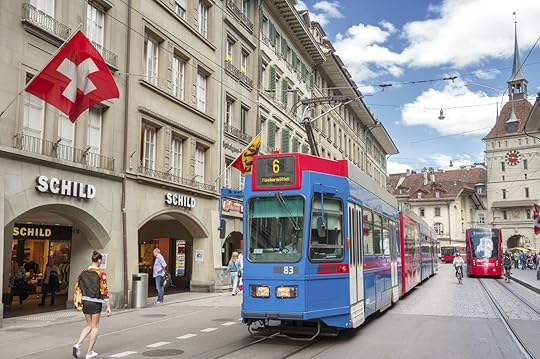
Photo: Lee Yiu Tung/Shutterstock
Swiss transportation is extremely developed and among the best in the world. There’s even a museum on Swiss transportation in Lucerne (which you can reach by train from Bern in about an hour and a half). The country’s train system is incredibly efficient with a plethora of options for every kind of traveler, from business to tourist, and the well-maintained roads keep drivers moving quickly too. An integrated experience, the Swiss Travel app just launched in summer 2018 and makes planning travel easy within the city and surrounding area. For an even easier experience, download the SBB Mobile app, which presents full transportation details when a countryside destination needs to be reached by bus after hopping off the train. With the app, locals and visitors to the city and country will never have to second guess at which platform their transfer will arrive. Passengers can also count on those trains to arrive on time. According to The Local, an English-language paper in Switzerland, more than 90 percent of trains operated by SBB arrive on time, the most punctual of any train system in Europe.
2. Use space intelligently to prevent urban sprawl.

Photo: gevision/Shutterstock
Akin to the well-oiled machine of public transportation, good urban design is another subtle but powerful attribute of Bern. The city’s clean, organized presentation and layout contribute to the ease in which it and its residents operate. Beyond the functionality of good design and on to the aesthetic, the sandstone buildings of Old Town are as beautiful as they are because they have been immaculately preserved and maintained. This, in turn, ensures their history is remembered. For example, the street signs in Old Town are color-coded and date to Napoleonic times. Bern was conquered in 1798 and occupied by French soldiers who could not read the German names — especially after a visit to the pub. The solution: Color code the troops and the streets, so they could find their way home.
Bern is also quite fond of repurposing standing structures for modern use. Today locals and travelers can shop, eat, or even catch a movie in the repurposed wine cellars in the former residential homes of Old Town. By preserving existing architecture and the stories that live within the structures, layers of history and intrigue are added while eliminating fabrication waste and urban sprawl.
3. Eat well. Live healthily.
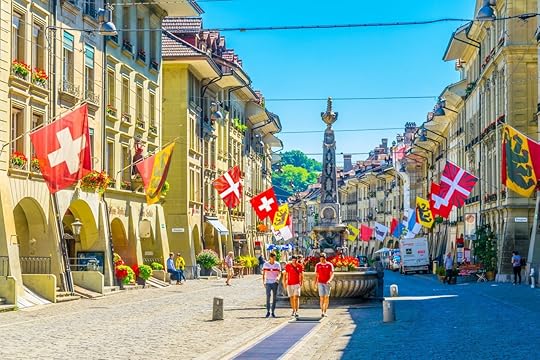
Photo: trabantos/Shutterstock
As a university town, Bern is filled with many diverse restaurants, bistros, café-bars, and healthy dining options. An array of cultures and access to local, organic produce; dairy; and meat allows for the freshest meals to be cooked and served. While travelers will certainly find calorie-dense treats and dishes — the Swiss do love their cheese — there are significantly more health-forward options that are readily available in Bern. Sure, there’s a Burger King, but there are many other quick service options like Tibits, which specializes in vegetarian and vegan fare. Having reasonably priced dining options that promote healthy eating in a tasty, easy way means that residents can eat smart and live well without a second thought.
4. Take time for yourself.
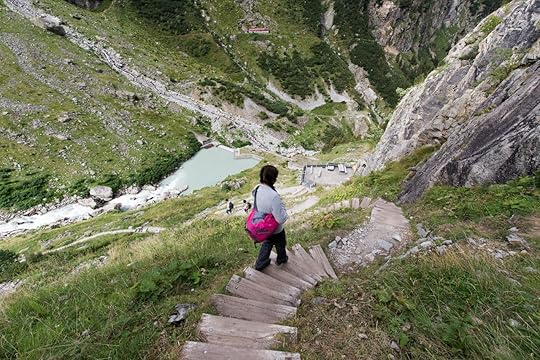
Photo: Lenush/Shutterstock
Among the most notable qualities of Bernese living is locals’ insistence on taking time out for themselves each day. Quality alone time is so important, and here, you’ll find it comes in a couple of varieties: health, wellbeing, and wide-open free time. Bern is also very bike-friendly, a popular way to get around as an alternative to taking the train, and the city’s public plazas and walking promenades, known as arcades, ensure walking is always an option even when the weather is foul. You can rent a bike and pedal through town or take a stroll through the arcades on foot. Here, taking care of oneself does not automatically equate to making purchases — it’s all about taking time to get outdoors and enjoy the fresh air. The city is home to clean, beautiful outdoor public pools that anyone is welcome to use for laps when the weather permits. The Aare river, which snakes around and through the city’s outer neighborhoods, features hiking trails along its banks. The Swiss are famous for their relaxed attitude and active lifestyle, and they know that empty free time is essential to avoid burnout.
5. Public education can be superb — when it’s given the right attention.

Photo: trabantos/Shutterstock
Bern’s public system, like that of Switzerland as a whole, is consistently ranked among the world’s best by major publications including The Telegraph. And the Swiss take full advantage of this — 95 percent of Swiss children attend public schools, enjoying personalized care and support. As 20 percent of the student population is foreign-born, many courses are taught in multiple languages. While you likely won’t be hanging out in Bern’s public schools during a visit, you can still learn a thing or two about the city’s culture and history. Choose from nearly 20 museums and cultural venues to visit, and learn about everything from art and history to science and Swiss Alpine culture. Don’t miss the Abegg Foundation, Einstein’s House, or the Salvation Army Museum, of which Bern is the headquarters. Albert Einstein, the most notable foreigner to live in Bern, even has an entire museum in his honor. 

More like this: The 7 most adorable villages in Switzerland
The post 5 things US cities can learn from Bern, Switzerland appeared first on Matador Network.

New Tarantino-themed bar in Brooklyn

Brooklyn is no stranger to themed bars, and this Quentin Tarantino-themed bar is the latest to hit Williamsburg. KillBar will be decked out in all things Tarantino, including movie Easter eggs, artwork, an Inglourious Basterds-inspired bartop, six-foot tall painting of Uma Thurman from Kill Bill, and massive projector screens on the walls showing scenes from Tarantino films. Activities also include special movie nights on Mondays and trivia on Tuesdays.

Photo: KillBar/Facebook
According to the bar’s website, “Art installations are displayed throughout the venue to give each patron a completely unique and immersive experience, letting you step into your favorite QT films… come in and help us raise a glass to Quentin Tarantino’s unique and inspiring gift for storytelling.”
The bar’s offerings will also, of course, be on brand. You can eat a Kill Bill Burger, Hateful Eight wings, Texas Funeral Grilled Cheese, and drink Mr. Pink Martinis and mezcal shots inspired by From Dusk Till Dawn. Conceptually, the bar is the brainchild of owner Michael Galkovich who used to own the now-closed ‘80s themed GB85 bar on the Lower East Side.
Killbar is located at 82 South 4th Street in Williamsburg and opens to the public on February 1. 
H/T: TimeOut

More like this: 8 bartenders on the bar they’d travel the world to visit
The post A Quentin Tarantino-themed bar is coming to Brooklyn appeared first on Matador Network.

Coolest lighthouses in the world

Lighthouses were once an integral part of any coastal seafaring culture. Their purpose wasn’t to look pretty but to give ships a point of reference in dark or bad weather. Their operators were akin to air traffic controllers, responsible for marking dangerous reefs, rocks, and coastlines, so ships could reach their destinations safely. Now, due to the advent of modern technology, lighthouse keepers have been largely replaced by electronic navigational systems; the lighthouses themselves, however, are still standing. More than just monuments to an out-of-date technology, they remain some of the most picturesque and recognizable coastal sights in the world.
1. Eldred Rock Lighthouse, Alaska
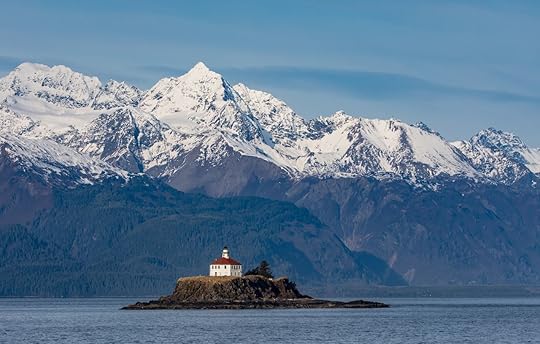
Photo: Richard Seeley/Shutterstock
The Eldred Rock Lighthouse is an octagonal-shaped structure located on Eldred Rock, a small island in Lynn Canal in southwestern Alaska. The lighthouse was built between 1902 and 1905 in response to several disastrous shipwrecks close by. The lighthouse was first lit in 1906 and was decommissioned in 1973. The oldest original lighthouse in Alaska and one of the most remote in North America, the Eldred Rock Lighthouse’s most striking feature is its stunning mountainous backdrop. The Eldred Rock Lighthouse Preservation Association of Haines, Alaska, endeavors to restore, maintain, and preserve the historic Eldred Rock Lighthouse.
2. Tower of Hercules Lighthouse, Spain

Photo: Tono Balaguer/Shutterstock
The Tower of Hercules Lighthouse, located at the entrance of La Coruña Harbor in Galicia, Spain, has been in use since the late first century AD. The only fully preserved Roman lighthouse that is still used for maritime signaling, the Tower of Hercules is a UNESCO World Heritage site. The lighthouse was built on top of a 187-foot-tall rock jutting into the Atlantic Ocean. The lighthouse was restored and augmented in the 18th century. You can tour the lighthouse every day of the week.
3. Les Eclaireurs Lighthouse, Argentina
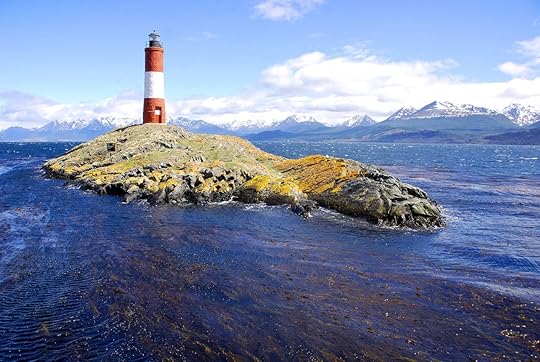
Photo: meunierd/Shutterstock
Located in the Beagle Channel, off the town of Ushuaia on the southern tip of Argentina and pretty darn close to Antarctica, this lighthouse has truly earned its nickname of “The Lighthouse at the End of the World” (though it’s not the one from Jules Verne’s novel The Lighthouse at the End of the World). Put into service in 1920 and decorated in red and white stripes, the lighthouse sits on a small island surrounded by the beauty of the snowy mountain peaks of Tierra del Fuego. The lighthouse is fully automated and cannot be visited by the public but can be seen during boat tours of the region.
4. Tourlitis Lighthouse, Greece
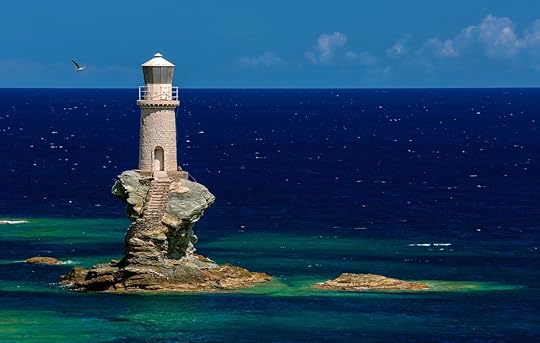
Photo: Lemonakis Antonis/Shutterstock
The Tourlitis Lighthouse looks like it’s straight out of Harry Potter. It sits atop a narrow stone spire poking out of the Aegean Sea off the Greek island of Andros. Originally built in 1897, the lighthouse was destroyed in World War II and rebuilt on the rock in the early 1990s. The stone spire was shaped by thousands of years of erosion, making it the optimal pedestal for a lighthouse (both functionally and aesthetically). Adding to its fantasy-like appearance, a carved stone staircase winds up the rock to the structure itself. After its reconstruction, Tourlitis became Greece’s first automated lighthouse, operating without an on-site keeper.
5. Pigeon Point Light Station, California
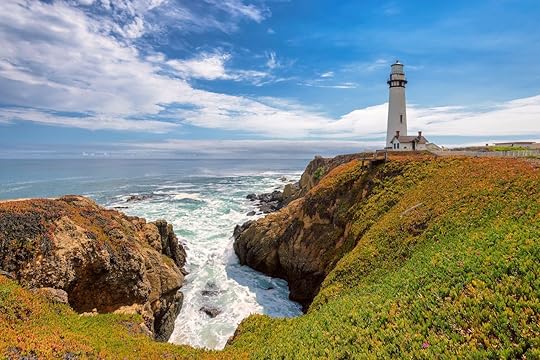
Photo: Lucky-photographer/Shutterstock
One of the tallest lighthouses in America, The 115-foot Pigeon Point Lighthouse is part of a State Historic Park located 50 miles south of San Francisco. First lit on November 15, 1872, the lighthouse has been modernized and is still an active US Coast Guard aid to navigation. If you want to wake up to amazing views of the lighthouse and the Pacific Ocean, book a room at the Hostelling International Pigeon Point Lighthouse, located right beside the lighthouse.
6. Whiteford Point Lighthouse, Wales
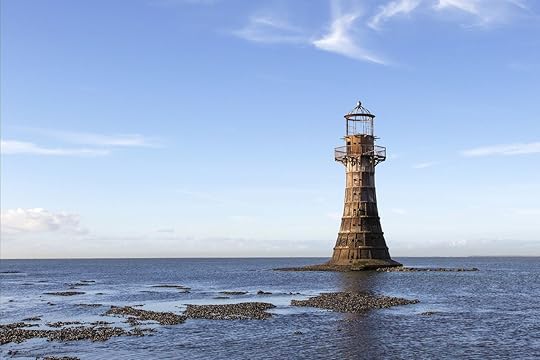
Photo: jax10289/Shutterstock
The Whiteford Lighthouse off Wales’ Gower Peninsula is the only cast-iron lighthouse in Britain that is surrounded by the sea at high tide. Built in 1865 to indicate the location of Whiteford Point and its shallow waters, this beautiful lighthouse was operational until 1926. Surprisingly, this unique structure served as a target for bomb practice for the Royal Air Force during WWII but remained standing. In 2000, the lighthouse was put up for sale for $1.31 and was bought by a TV company who vowed to renovate it. You can walk to the lighthouse at low tide, but be cautious as silt and rising waters can be dangerous.
7. Earhart Light, Howland Island

Photo: Horton Point Lighthouse/Facebook
Located on Howland Island, a 648-acre uninhabited island halfway between Hawaii and Australia, Earhart Light truly stands alone in the middle of nowhere. In 1937, a runway was built on the island for Amelia Earhart to be able to refuel while on her circumnavigation of the globe. Unfortunately, she and Fred J. Noonan never made it. The island was briefly occupied during WWII, but attacks by the Japanese air and naval armies led to an evacuation and the partial destruction of the lighthouse — though it was rebuilt in the 1960s. Earhart Light, named in memory of the aviator and located on the west coast of the remote island, is used as a day beacon, but it is in very poor condition. Howland Island is a National US Refuge and can only be accessed with a permit.
8. Chania Lighthouse, Crete, Greece
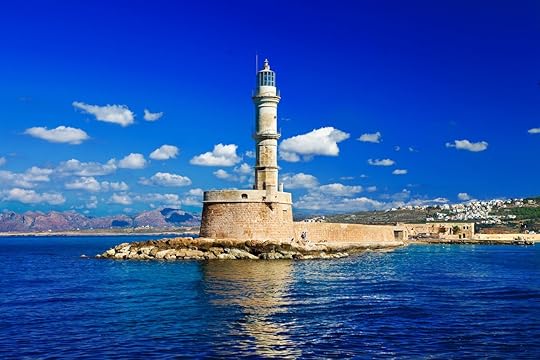
Photo: leoks/Shutterstock
The Chania Lighthouse, originally built in the 16th century, is located opposite the Firkas fortress in the old port of Chania in Greece. Today, only the base of the lighthouse dates back to the 16th century as the structure was renovated and shaped like a minaret between 1824 and 1832. While the older version was known as “the Venetian Lighthouse,” its modern version is referred to as “Egyptian” because it was built when Crete was occupied by Egyptian troops supporting the Ottoman Empire against the Cretans. While visitors aren’t allowed inside the lighthouse, you can still walk along the harbor and climb the exterior stairs for a fantastic view of the Sea of Crete.
9. Portland Head Light, Maine
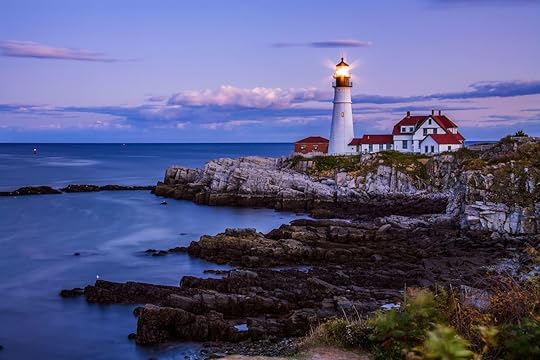
Photo: Doug Lemke/Shutterstock
Portland Head Light, located on Cape Elizabeth in Maine, was first lit on January 10, 1791, and decommissioned and automated on August 7, 1989. As such, it is one of the state’s oldest lighthouses. The former keepers’ quarters, built in 1891, have been converted into a museum containing lighthouse lenses and interpretative displays. The tower is only open in September on Open Lighthouse Day when access is very limited, but if you make it to the top, you’re sure to have a stunning view of Maine’s rocky coastline and the Atlantic Ocean. 

More like this: 9 lighthouses you can actually stay in
The post The 9 most unique lighthouses in the world appeared first on Matador Network.

Matador Network's Blog
- Matador Network's profile
- 6 followers



